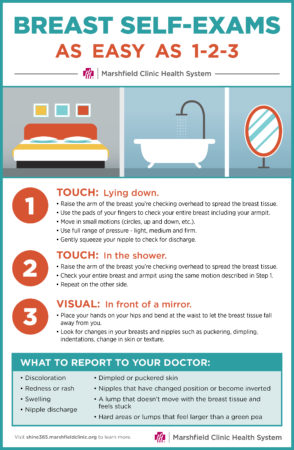Breast cancer affects an average of 1 in 8 women and kills nearly 500,000 women per year. These sobering facts can incite panic or worry, but there is an easy way to regularly keep an eye on your breast health: breast self-exams.
Why do breast self-exams?
“If a woman gets to know the breast tissue and is feeling the glands every month, she will be the first one to recognize if the breast is changing,” explained Ann Sommer, a Marshfield Clinic Health System OB/GYN physician assistant. “It is just as important to see a provider for a clinical breast exam because they are trained to find things that patients might not notice or worry about. They are also able to screen for risk factors in a patient’s medical history.”
Adult women of all ages are encouraged to perform breast self-exams once a month. Not all providers have the same recommendations about performing breast self-exams. But Sommer explained, “The providers at Marshfield Clinic Health System feel that it is important to teach patients how to do self-exams and what to look for.”
Performing regular self-exams can help you become familiar with how your breasts look and feel. So if you notice something is different or doesn’t feel right, you can have a mammogram done to catch anything sooner than you would if you wait for regular checkups.
A self-exam or clinical breast exam should not replace a mammogram. Mammograms are the most reliable way to detect breast cancer and you should follow your doctor’s screening recommendations. However, some breast cancers may first be found by self-exam rather than by mammography.
Self-exams help you become familiar with how your breasts look and feel so you can let your health care provider know about any changes as soon as you notice them.
How to perform a self-exam
Breast self-exams only take a few minutes, and you only have to do them once a month.
Sommer said that the best time to perform a breast self-exam is 7-10 days after your menstrual cycle starts. At that time, the breast tissue is back in its normal state; during a menstrual cycle, the tissue changes and is affected by hormones, often feeling tender or lumpy.
If you no longer have periods, choose a day of the month you can remember to perform an exam and make a note in your calendar or cellphone.

What if I notice a problem?
“When we notice that something is wrong, we are programmed to panic,” Sommer said. “But on a scale from 0-10, your panic level should be a 3-4. We are not going to panic until we have to. But be sure to schedule an appointment and don’t ignore what you find that worries you.”
Breast changes are a normal result of aging and changing hormone levels. Most changes aren’t cancer, but don’t wait until your next doctor’s appointment or mammogram to get them checked. Be sure to contact your primary care provider or OB-GYN to let them know about your concerns.
Related Shine365 stories
Advanced imaging improves breast cancer detection


This is a really helpful and easy way to walk someone through doing a self exam. It's always something that I forget when I see my doctor. How often are you supposed to do this check? Every month?
Yes; once a month is recommended: "Adult women of all ages are encouraged to perform breast self-exams once a month." Thanks for reading. -Kirstie